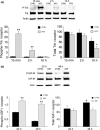Directing traffic in neural cells: determinants of receptor tyrosine kinase localization and cellular responses
- PMID: 18248622
- PMCID: PMC5513677
- DOI: 10.1111/j.1471-4159.2008.05263.x
Directing traffic in neural cells: determinants of receptor tyrosine kinase localization and cellular responses
Abstract
The trafficking of receptor tyrosine kinases (RTKs) to distinct subcellular locations is essential for the specificity and fidelity of signal transduction and biological responses. This is particularly important in the PNS and CNS in which RTKs mediate key events in the development and maintenance of neurons and glia through a wide range of neural processes, including survival, proliferation, differentiation, neurite outgrowth, and synaptogenesis. The mechanisms that regulate the targeting of RTKs to their subcellular destinations for appropriate signal transduction, however, are still elusive. In this review, we discuss evidence for the spatial organization of signaling machinery into distinct subcellular compartments, as well as the role for ligand specificity, receptor sorting signals, and lipid raft microdomains in RTK targeting and the resultant cellular responses in neural cells.
Figures





Similar articles
-
Endocytosis of receptor tyrosine kinases.Cold Spring Harb Perspect Biol. 2013 May 1;5(5):a017459. doi: 10.1101/cshperspect.a017459. Cold Spring Harb Perspect Biol. 2013. PMID: 23637288 Free PMC article. Review.
-
Charming neighborhoods on the cell surface: plasma membrane microdomains regulate receptor tyrosine kinase signaling.Cell Signal. 2015 Oct;27(10):1963-76. doi: 10.1016/j.cellsig.2015.07.004. Epub 2015 Jul 9. Cell Signal. 2015. PMID: 26163824 Review.
-
Receptor tyrosine kinases are signaling intermediates of G protein-coupled receptors.Curr Pharm Des. 2004;10(28):3539-45. doi: 10.2174/1381612043382936. Curr Pharm Des. 2004. PMID: 15579051 Review.
-
Effects of membrane trafficking on signaling by receptor tyrosine kinases.Cold Spring Harb Perspect Biol. 2013 Nov 1;5(11):a009035. doi: 10.1101/cshperspect.a009035. Cold Spring Harb Perspect Biol. 2013. PMID: 24186066 Free PMC article. Review.
-
Regulation of receptor tyrosine kinase signaling by protein tyrosine phosphatases.Trends Cell Biol. 2001 Jun;11(6):258-66. doi: 10.1016/s0962-8924(01)01990-0. Trends Cell Biol. 2001. PMID: 11356362 Review.
Cited by
-
Regulation of neurotrophin receptor (Trk) signaling: suppressor of cytokine signaling 2 (SOCS2) is a new player.Front Mol Neurosci. 2014 May 14;7:39. doi: 10.3389/fnmol.2014.00039. eCollection 2014. Front Mol Neurosci. 2014. PMID: 24860421 Free PMC article. Review.
-
Orchestrating the synaptic network by tyrosine phosphorylation signalling.J Biochem. 2011 Jun;149(6):641-53. doi: 10.1093/jb/mvr047. Epub 2011 Apr 20. J Biochem. 2011. PMID: 21508038 Free PMC article. Review.
-
Insulin-like growth factor-I-stimulated Akt phosphorylation and oligodendrocyte progenitor cell survival require cholesterol-enriched membranes.J Neurosci Res. 2009 Nov 15;87(15):3369-77. doi: 10.1002/jnr.22099. J Neurosci Res. 2009. PMID: 19382214 Free PMC article.
-
Endosomal trafficking of the receptor tyrosine kinase MuSK proceeds via clathrin-dependent pathways, Arf6 and actin.FEBS J. 2013 Jul;280(14):3281-97. doi: 10.1111/febs.12309. Epub 2013 May 23. FEBS J. 2013. PMID: 23621612 Free PMC article.
-
Mutation of 3-hydroxy-3-methylglutaryl CoA synthase I reveals requirements for isoprenoid and cholesterol synthesis in oligodendrocyte migration arrest, axon wrapping, and myelin gene expression.J Neurosci. 2014 Feb 26;34(9):3402-12. doi: 10.1523/JNEUROSCI.4587-13.2014. J Neurosci. 2014. PMID: 24573296 Free PMC article.
References
-
- Aguirre A, Dupree JL, Mangin JM, Gallo V. A functional role for EGFR signaling in myelination and remyelination. Nat. Neurosci. 2007;10:990–1002. - PubMed
-
- Anton ES, Ghashghaei HT, Weber JL, et al. Receptor tyrosine kinase ErbB4 modulates neuroblast migration and placement in the adult forebrain. Nat. Neurosci. 2004;7:1319–1328. - PubMed
-
- Baravalle G, Schober D, Huber M, Bayer N, Murphy RF, Fuchs R. Transferrin recycling and dextran transport to lysosomes is differentially affected by bafilomycin, nocodazole, and low temperature. Cell Tissue Res. 2005;320:99–113. - PubMed
-
- Bartz R, Benzing C, Ullrich O. Reconstitution of transport to recycling endosomes in vitro. Methods Enzymol. 2005;404:480–490. - PubMed
Publication types
MeSH terms
Substances
Grants and funding
LinkOut - more resources
Full Text Sources

